World Mythology: Unique Characters of The Slavic Mythology
It may seem that I drastically changed the subject of the blog and abandoned science in favor of fairy tales. But, if you think about it, myths and fairy tales based on them, is the initial way of understanding the world.
The possibility of using words to give the form of a strange phenomenon, to understand the invisible and unexplored, giving it a shell of something familiar. This is the first form of knowledge transfer from person to person, from generation to generation. In a sense, old people in ancient tribes and wise shamans were the first scientists who shared their knowledge with the rest.
Most of us are familiar with Greek, Norse and Egyptian mythology. This is due to the advanced writing of these cultures. The oral form of knowledge storage is ephemeral and constantly distorted. Writing allowed us to obtain a large amount of information about the beliefs of those times. The entertainment industry contributed to the popularization of characters from these cultures.
However, even today, in the age of digital technology, parents around the world tell fairytales to their children. The stories they heard from their parents, stories that have roots in eternity. In every country, hundreds of amazing creatures live in these tales, simultaneously similar and so different. All of these beings - a reflection of the unique culture of the nation, in which they were born. And they continue to exist in the dying memory of adults and the living imagination of children.

Painting by Ivan Bilibin
I would like to tell You about some of them. It is quite logical that I will start with what I know, I will tell you about my fabulous "friends" of childhood- about the creatures of Slavic mythology. They are very authentic as any creature of local folklore.
Koschei the Deathless
The main antagonist of most Slavic fairytales. Mighty wicked wizard and king of the distant dark kingdom. Usually portrayed as a disgusting skeletal-looking old man with a long beard, sometimes as a warrior on a black horse.
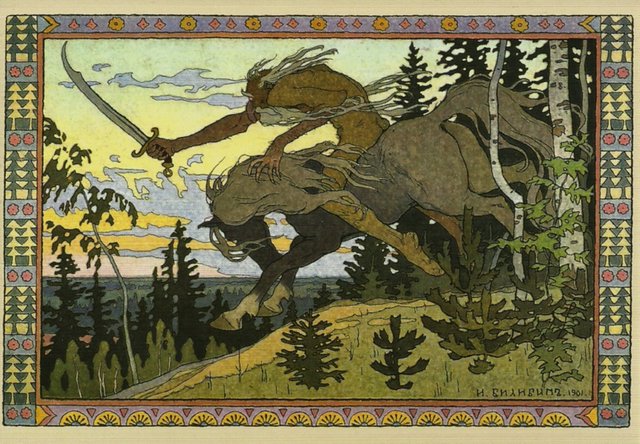
Painting by Ivan Bilibin
Koschei is immortal, but not in an absolute concept. To defeat Koschei the hero must find a magical island that constantly disappears.
In the middle of the island grows a huge oak, in whose branches hid the magic chest, inside which is a hare, inside which is a duck, inside which is an egg, inside which is a magical needle- the soul of Koschei. Break the needle and he will lose his power.
He is a very strong wizard, in some tales he was able to turn people into various objects or animals (nut, snake, frog). In another story, he bewitched the whole kingdom, completely turning it into stone. The water gives him great strength, after drinking three buckets he is able to break any chain.
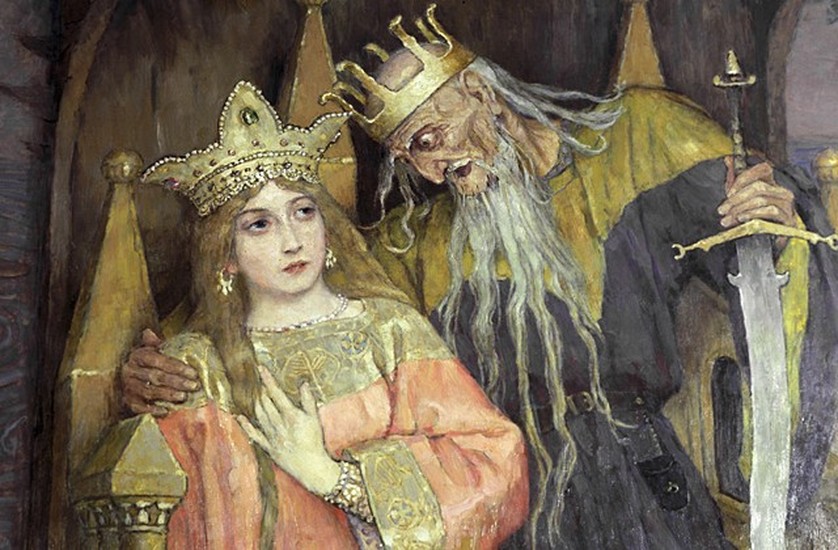
Painting by Viktor Vasnetsov
He got the image of the villain after the spread of Christianity, such fate was prepared for almost all pagan characters.
Initially, Koschei is the king of the underworld, the mighty spirit of earth and water, who guards the afterlife from the penetration of the living. His fabulous habit to kidnap young girls, obviously stems from the traditions of paganism- to bring young virgins in sacrifice to the gods.
Zhar-ptitsa (Firebird)
A beautiful bird with bright fiery feathers – burning like a flame. Appears in fairy tales as the target, test for the main character. He must get a feather from her tail. This may seem like an easy challenge but it is not. Her feathers are literally a living fire that can burn a man. She glows so brightly, that you will go blind after looking at her.

Painting by Ivan Bilibin
The Firebird eats Golden apples that give youth and beauty, her singing heals the sick. When the Firebird sings out of her mouth spilling pearls, and her eyes are two precious crystal.
The only way to catch the Firebird is to use the Golden cage with her favorite apples as a bait, but heat will quickly melt the trap, so the hero must hurry.
Outwardly she looks like a peacock, but her abilities are very close to another mythological creature – Phoenix. Indeed, the Firebird dies every autumn and is reborn anew with the coming of spring.
"The feather found shines brighter than any fire, and eventually becomes golden."
Some historians suggest that the Firebird is one of the guises of the God-blacksmith Svarog. She represents fire, light and knowledge. It's definitely a good creature, but it doesn't have a clear character and mind. Elemental force in its pure form, which could destroy or enrich the person if he is careful.
Baba Yaga "Bony leg"
The most famous character of Slavic folklore. Ugly old woman, with disheveled hair, a huge nose and bony leg. She is blind, and a huge nose helps her to find people by smell. In fairytales she is the evil forest witch and cannibal, possessed of great magical powers.
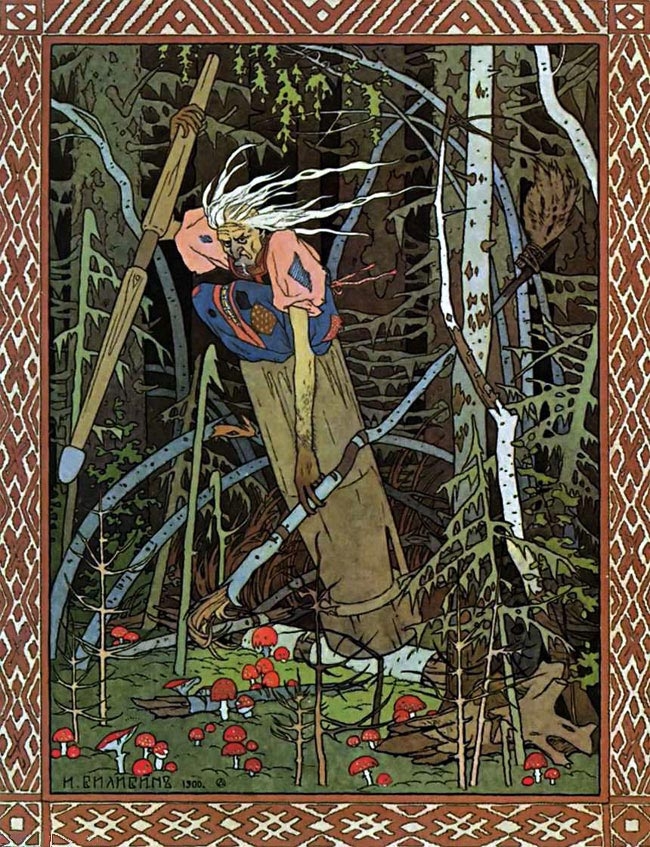
Painting by Ivan Bilibin
She lives deep in the woods in a hut on chicken legs, surrounded by a fence of human bones and skulls.
Unlike European witches, she flies not on a broom, but on stupa. She steals children under cover of night, and boil them alive in a huge cauldron. Using trickery and magic, she can kill a grown man.
In a childhood I thought that Koschei and Baba Yaga are married :)
In fact, her image is quite contradictory, in different stories Baba Yaga takes different roles. She can help the hero by giving him magic items, so he could defeat absolute evil (Koschei for example).
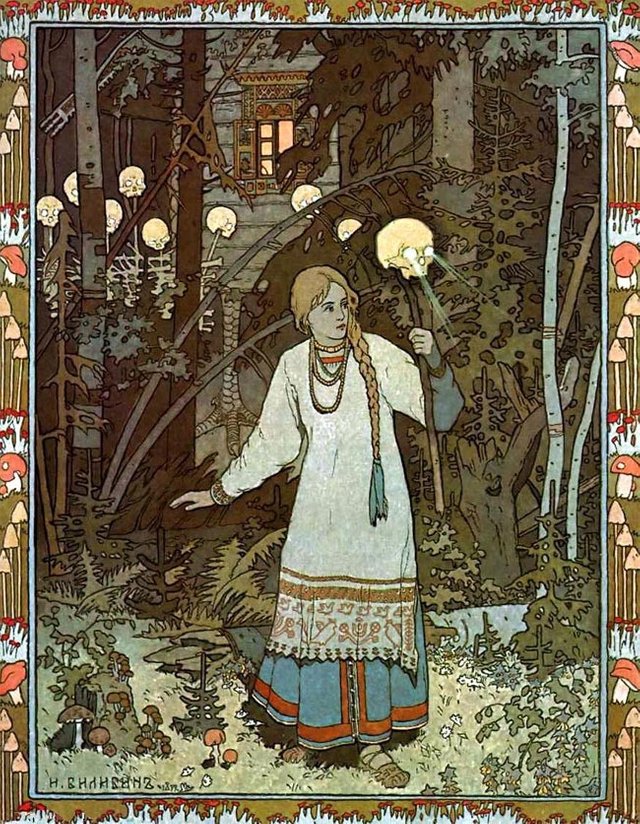
Painting by Ivan Bilibin
She is the guardian of the border between the world of the living and the world of the dead and the guide for the dead souls. That's why Baba Yaga has bony leg: with one leg she is standing in the world of the living and another in the netherworld.
Through different tests, she checks the hero and help him pass all the required rituals for the journey to the underworld and successful return.
Her magical abilities are rather extensive, like any witch, she has many servants among the animals and spirits. In one of the tales she was the mistress of three horsemen who symbolized the day, the sun and the night (white, red and black horsemen)- it turns out she could control the time. Sometimes she is the mother of other evil creatures - dragons, demons.
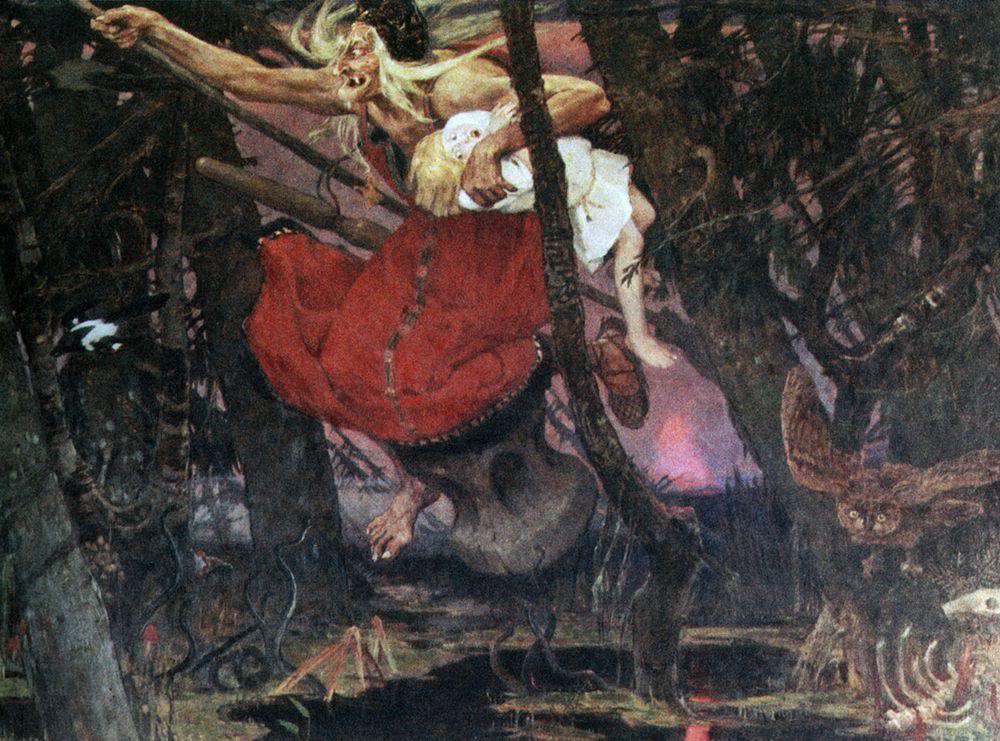
Painting by Viktor Vasnetsov
In the most ancient stories, she is the guardian of the forest and all creatures. Baba Yaga is not an evil symbol, but rather the embodiment of a severe nature, that does not forgive mistakes. Therefore, do not go too far into the forest, and don’t disturb its inhabitants and most importantly the guardian of the forest. Later this role passed to the Leshy.
Bannik
Everyone has heard about the Russian Banya (sauna), but not all Russians know about the Bannik. This junior spirit, in the guise of a little old man with a long beard. He is almost never mentioned in fairy tales, but true lovers of the bath know about his presence.
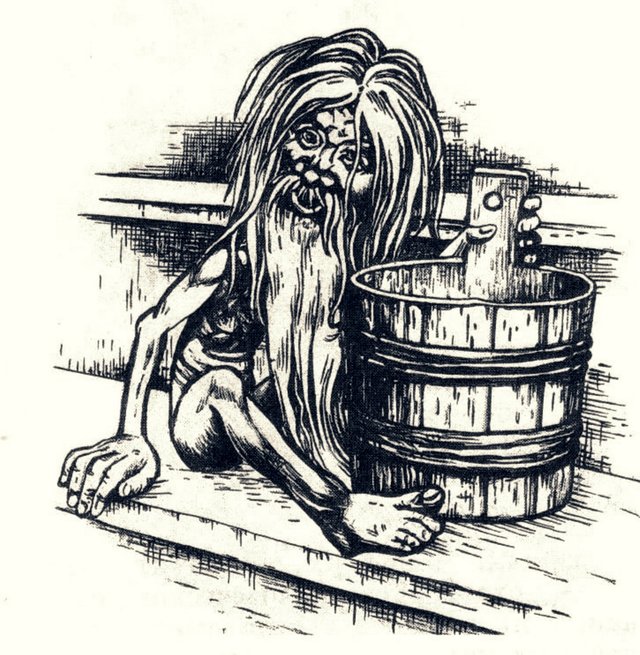
Painting by Ivan Bilibin
If while taking a bath you fell on a slippery floor, burned, fainted from the heat or hear strange sounds, rest assured, it is Bannik.
You can see him only at midnight, when he takes off his red cap of invisibility to wash.
He is not a negative character, but rather keeps order on his territory and reminds people that that the banya is not a place for fun, and the important ritual, sacred bathing, which aims to get rid of sins and will be reborn.
So, he's only hurting those people, who do not comply with rules - wash on holidays or late at night. Sometimes he can kill, trapping the person in a hot steam room. Or rip off the skin from the offender and throw him on the fiery furnace.
Often people tried to appease Bannik, feeding him with rye bread and salt. They believed that this spirit is able to predict the future.
"At midnight, the young girls approach the open doors of the bathhouse, lifting their skirt. If Bannik touches her with shaggy hand - the girl will have a rich fiance, if by naked hand - poor, and if wet - a drunk."
This is a pretty authentic character, purely a figment of the Slavic imagination, which is not found in other cultures in which there is a banya/sauna.
Chudo-Yudo
I don't even know how to translate this name into another language, and this reflects the whole meaning of this strange monster. In the most ancient mentions, it does not have a clear character (good or evil). It’s gender is constantly changing. Apparently, it is a chthonic creature, wild, unbridled power of the element of water.
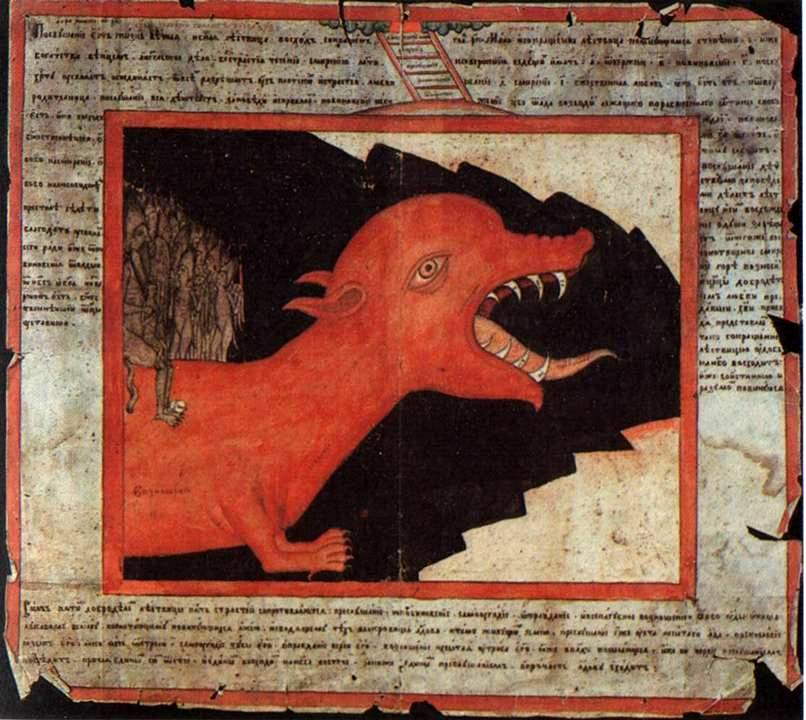
image source
In later stories, it starts to get fuzzy appearance, something similar to dragon. The snake-like creature with multiple heads and tails, living in the sea. His power is enormous and is comparable with the strength of Titans and Giants from other cultures.
Chudo-Yudo becomes absolute evil, the main antagonist in the tales. It becomes reasonable and combines the features of human and snake, it has witch wife and mother-snake. This monster with 12 heads is capable of burning cities and kingdoms.
But, most of the children are familiar only with his latest form: Chudo-Yudo-Ryba-Kit (Chudo-Yudo-Fish-Whale). He is so big that people built a city on his back.
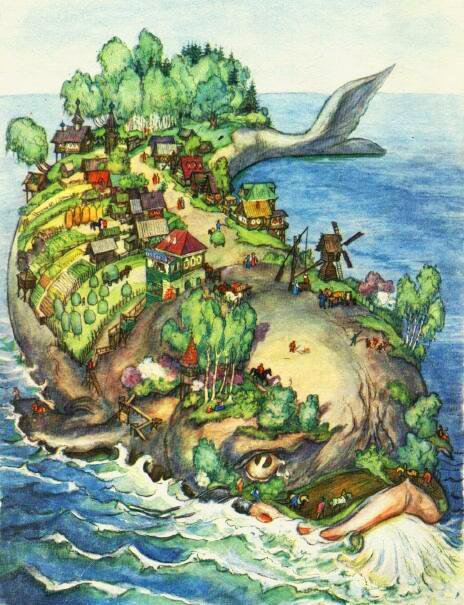
image source
The Gods punished a huge whale because he swallowed dozens of ships when he was free. People will continue to live on his back and torture his body until he spit back the swallowed ships.
Leshy
Leshy is the forest spirit, defender of animals, birds and all plants. Meets in many fairy tales, often acts as a helper of the protagonist, or are a minor pest. But in the original mythology it is a cruel evil spirit, hostile to people.
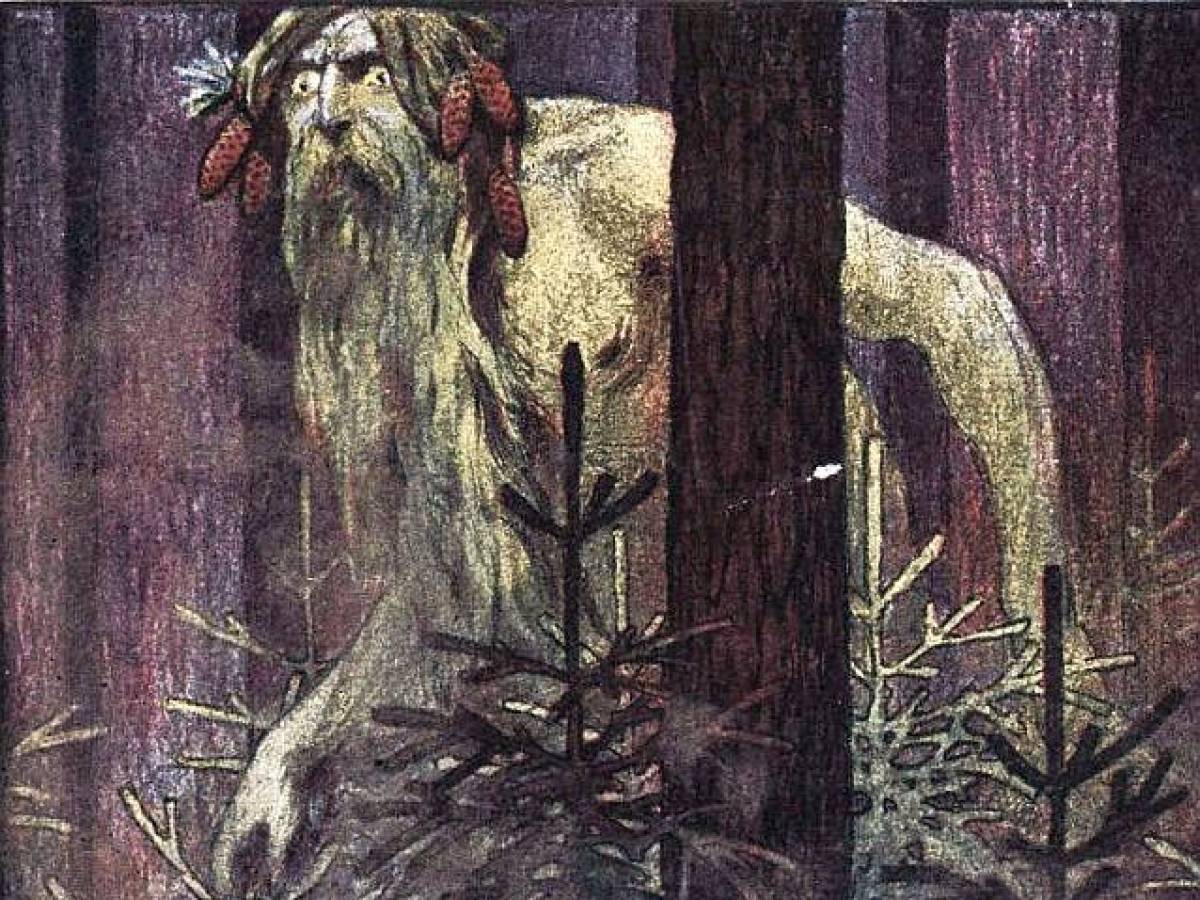
Painting by Mikhail Vrubel
It is difficult to describe his appearance, because he is able to transform into anything: into the grass or fungus, any animal or even human, can move under the earth and in the sky. In front of people most often appears in a humanoid form.
If you meet in the woods the stranger, then carefully look at him, there are three signs to identify the Leshy: the eye is bright green, shoes are dressed in reverse (heels forward), he has no shadow.
Usually the Leshy hurts only people, who behaves badly in the forest. It can lure a man deep in the forest and leave him at the mercy of the beasts. Likes to intimidate and deceive people with different sounds (claps or shouts).
Most often he makes people lost in the woods forever. The Leshy bypasses the man in a circle, thus he creates a closed magical zone and carries the mortal from the world of the living, into the world of spirits, from which there is no way out.
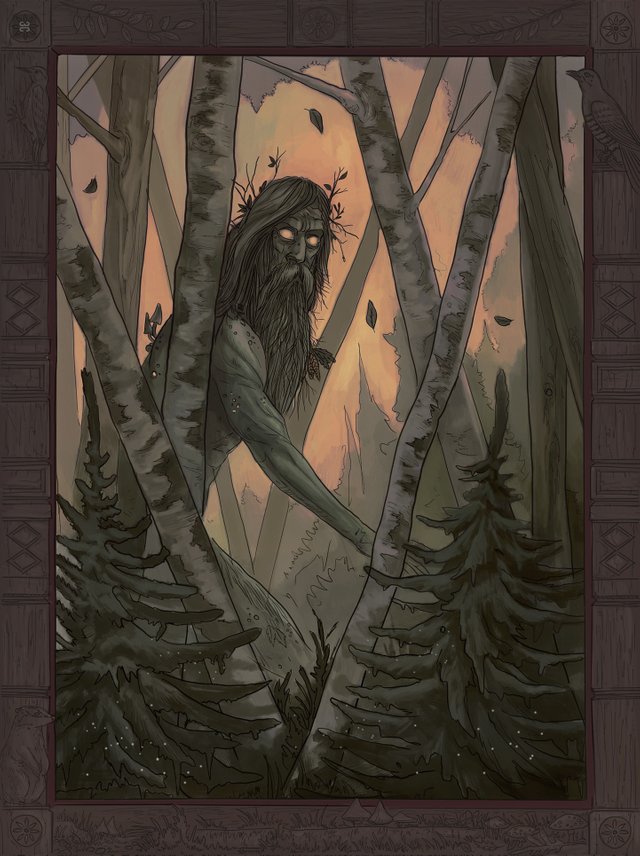
image source
Sometimes The Leshy might steal the baby, if the baby was cursed by his parents or relatives. Instead of the baby, he placed in a lullaby a piece of wood or magic fake. Fake takes the form of a stolen child, but it was a distorted, ugly image that could not walk and speak, after a while he turned into a straw or rotten wood.
Today The Leshy turned into a jolly old man, who lives in the woods, he loves to play cards and drink. He does not cause evil to people, and can use magic only for the sake of joking. But the old men remember, that you should not get angry forest spirit, and to break the boundaries that he set.

The original name of any mythical creature is not just a word, it is a term, describing the very essence of this creature. From father to son, from son to his son and on, for hundreds of years, words have lost their original value, people have forgotten their meaning, distorted.
Fairytales have ceased to be the primary science about the physical world, and first of all they began to teach us morality. Because of this, fictional characters today seem to us strange and unrealistic, but for our ancestors they were as real as the ground beneath their feet, a burning fire or a murmuring stream.

Painting by Viktor Vasnetsov
This is only a small part of the characters of the Slavic folklore, we will definitely return to them. In the future, I will also introduce you with other mythological beings from around the world. Among them, you will find strange gods, spirits and beasts. Together we will try to find out what they symbolized to our ancestors.
***
sources: Based on the works of Alexander Afanasyev "Mythology Of Ancient Russia", on the Alexander Pushkin fairytales, and on the stories of our parents and grandparents.

Great post! European folklore is very rich and help us see the world throught the eyes of those who live in those times.
Like you said these caracthers are the manisfestation of the world to them!
Thank you!
Thank you for reading!